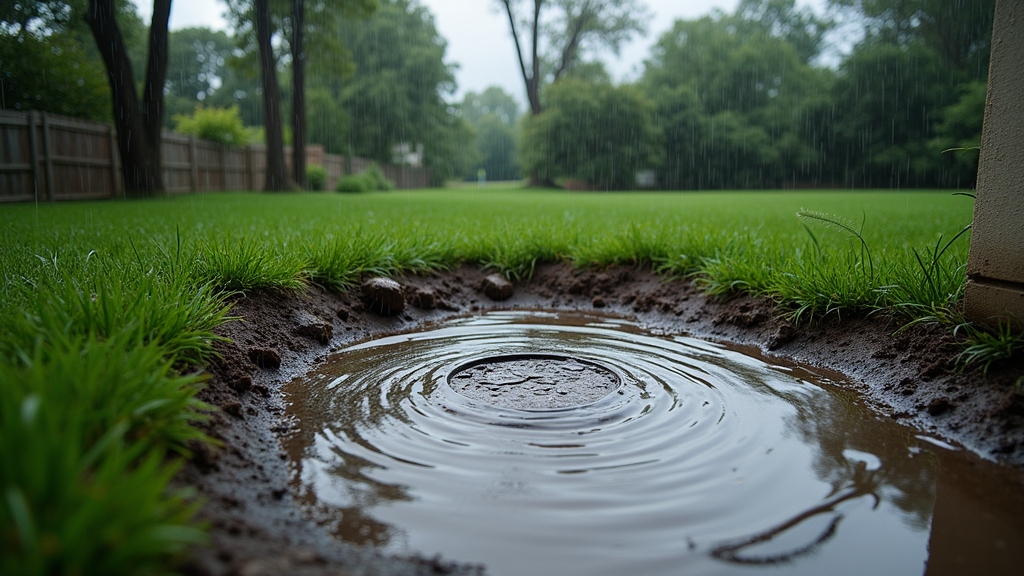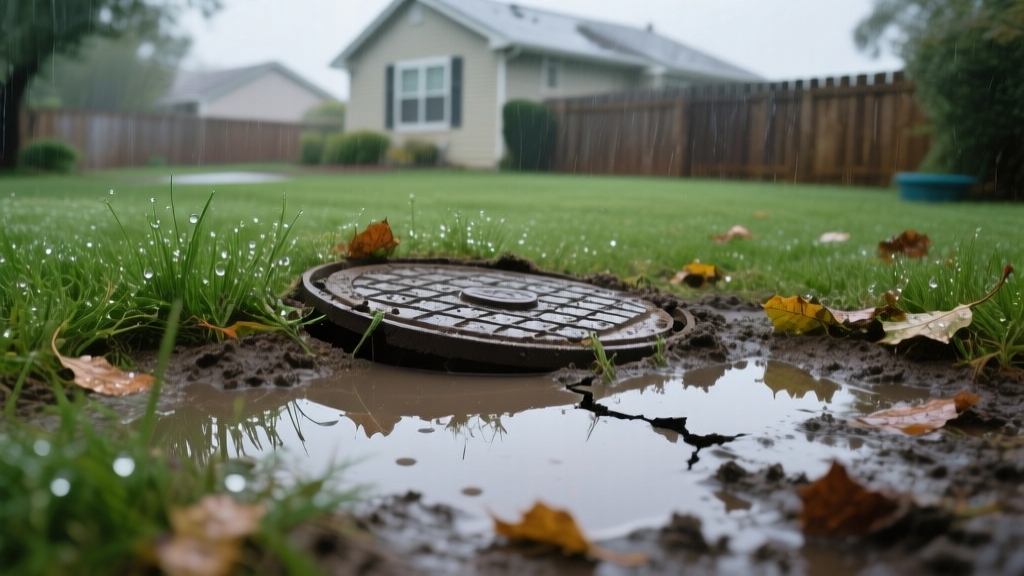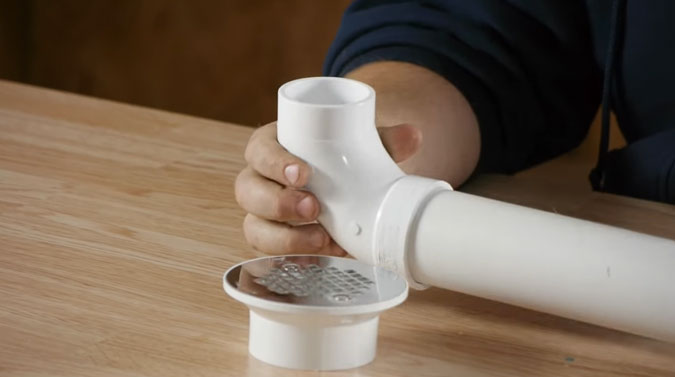Yes, heavy rain can cause your septic system to back up by saturating the soil and drain field around it, which limits wastewater absorption.
When the soil becomes waterlogged, your system may become hydraulically overloaded, causing untreated sewage to surface or flow back into your home.
This overload reduces microbial breakdown of waste and increases contamination risks. You’ll also notice symptoms like slow drains and odors.
Understanding these factors and how to protect your system can prevent costly damage and health hazards.
Key Takeaways
- Heavy rain saturates soil around septic drain fields, reducing absorption and causing wastewater to back up into the system.
- Excess rainwater inflow can hydraulically overload septic tanks, leading to slow drainage and sewage backups in the home.
- Saturated drain fields prevent proper effluent percolation, increasing risk of untreated sewage surfacing or contaminating groundwater.
- Signs of septic backup from heavy rain include foul odors, gurgling drains, pooling water near the drain field, and sewer backups.
- Immediate action after backup includes limiting water use, avoiding contact with sewage, and contacting septic professionals for inspection and cleanup.
How Heavy Rain Impacts Septic Systems?

When heavy rain saturates the soil around your septic system, it directly impairs the drainfield’s ability to absorb and treat wastewater.
Saturated soil becomes waterlogged, preventing septic effluent from percolating adequately, which causes pooling or surface discharge. This saturation lowers oxygen levels, inhibiting the microbial activity essential for breaking down contaminants.
Additionally, heavy rain increases total water input, mixing rainwater infiltration with household wastewater and causing the septic tank to fill beyond capacity. As a result, wastewater may back up into your home’s plumbing, including toilets and sinks.
Prolonged saturation can lead to slow drainage, septic tank overflow, and long-term drainfield failure if unaddressed. This combination of soil saturation and system overload compromises your septic system’s performance and can accelerate mechanical wear due to wear and tear on system components.
Runoff from heavy rain can also contaminate groundwater and nearby wells, posing serious health risks.
Common Causes of Septic Backups During Rainstorms
When it rains heavily, the drainfield soil can get really saturated. What happens is that it can’t absorb wastewater properly anymore. This leads to a backup of excess water into your plumbing. If your septic system’s drainfield is already compromised or just too small, this situation can get even worse.
Understand how this saturation in the drainfield can trigger these backups. Flooded drainfields can cause untreated sewage to enter groundwater and streams, posing environmental risks.
Knowing this can really help you manage your septic system better, especially when storms roll in. Proper system design and maintenance can reduce the risk of system backups during heavy rain.
Excessive Water Inflow
Because excessive water inflow overwhelms septic systems, it often triggers hydraulic overload during rainstorms.
When you run multiple high-volume water activities simultaneously, like laundry, showers, and dishwashing, the septic tank receives too much wastewater at once.
This surge prevents proper solid-liquid separation and reduces settling time, hindering bacterial breakdown. This condition is similar to how a failing pressure tank can cause fluctuations by losing its ability to maintain balance.
Consequently, solids can pass through the system, increasing backup risk. Additionally, excess water pressure stresses system components, potentially causing structural damage such as cracked pipes or deteriorated joints.
A blocked septic filter can worsen backups during heavy rain by obstructing effluent flow and causing wastewater to back up into the home. To avoid this, you should spread out water-intensive tasks and maintain regular pumping schedules.
Monitoring water usage during rainstorms is vital to prevent hydraulic overload, preserve system integrity, and reduce the likelihood of septic backups caused by excessive inflow.
Drainfield Saturation
How does heavy rain impact your septic system’s drainfield? Excessive rainfall saturates the soil around your drainfield, reducing its ability to absorb and filter effluent from the septic tank.
When the soil becomes saturated, it can’t process wastewater effectively, causing effluent to pool on the surface or back up into your plumbing fixtures. This leads to unpleasant odors, unsanitary conditions, and potential health hazards. Limiting household water use during and after heavy rainfall can help reduce system strain.
Additionally, the use of water-efficient fixtures can lessen the volume of wastewater entering the system, helping to prevent overload.
Prolonged saturation can permanently damage your drainfield, requiring costly replacement or connection to public sewer systems. Common causes include groundwater infiltration, flooding, soil compaction, root intrusion, and clogged pipes.
Signs of saturation during rainstorms include slow drainage, soggy ground, gurgling sounds, and standing water. To protect your system, manage water use carefully and prevent soil compaction around the drainfield.
Health and Environmental Risks of Septic Backups
When your septic system backs up during heavy rain, it can be a real mess. Raw sewage can seep into your property and even contaminate nearby groundwater.
That’s not just inconvenient; it poses serious environmental hazards. Heavy rainfall can cause ground flooding around the drain field, overwhelming the system’s ability to process wastewater. Homes on high ground are typically less prone to these issues due to their geographic location.
This kind of contamination can increase the risk of waterborne diseases, which means you and your family could be exposed to harmful pathogens. Yikes!
That’s why it’s so important to understand these health and pollution risks. Knowing what to look out for can really help with prevention and response.
Sewage Contamination Hazards
Although septic backups may seem like localized inconveniences, they pose significant health and environmental hazards due to the complex mixture of pathogens, chemical pollutants, and antibiotic-resistant genes they release.
When a septic system fails, you’re exposed to enteric viruses like norovirus and hepatitis A, which can cause gastrointestinal and respiratory infections. Installing a properly designed system, including chlorine injection for well water, can help reduce microbial contamination risks.
The sewage also contains antibiotic-resistant genes and microplastics, indicating treatment inefficiencies and environmental dissemination.
Contact with contaminated water elevates your risk of diarrheal diseases, cholera, and helminth infections, impairing nutrient absorption and causing malnutrition. In fact, over 829,000 deaths annually are caused by diarrhea linked to unsafe water, sanitation, and hygiene, highlighting the severity of these health risks (impact on health).
Additionally, inhaling sewage gases can trigger respiratory symptoms, eye irritation, and systemic toxicity from chemical pollutants.
These contaminants collectively create a hazardous exposure environment, demanding prompt remediation to protect both human health and surrounding ecosystems.
Groundwater Pollution Risks
Septic backups not only expose you to direct contact with hazardous contaminants but also pose significant risks to groundwater quality, especially during heavy rain events.
Saturated soils and flooded drain fields can allow untreated sewage to bypass natural filtration, infiltrating groundwater and nearby wells.
Proper maintenance, including regular inspections and pumping, helps prevent system failures that exacerbate these issues. Regular drain field inspections can detect early signs of failure before contamination occurs.
This contamination introduces nutrients, pathogens, and chemicals that degrade aquatic ecosystems and compromise drinking water supplies.
You need to be aware that:
- Heavy rain limits drain field absorption, increasing untreated effluent flow into groundwater.
- Flooded septic systems elevate contamination risks in high water table areas.
- Nutrient and pathogen influx harms aquatic biodiversity and causes eutrophication.
- Shallow wells near septic systems are especially vulnerable to pollution during storms.
Understanding these mechanisms helps you mitigate environmental impacts and protect water resources effectively.
Human Health Implications
Because heavy rain saturates the ground and overwhelms drain fields, your home’s wastewater system can back up. This can expose you to harmful pathogens like bacteria, viruses, and parasites.
Direct contact with raw sewage or contaminated surfaces raises risks of gastrointestinal illnesses and skin infections. Inhalation of odors may cause respiratory irritation or worsen preexisting conditions. During heavy rain and storms, it is important to minimize household water use to reduce system overload and lessen backup risks reduce water input.
If sewage contaminates your drinking water well or groundwater, pathogen exposure intensifies, posing serious health threats. Proper cleanup requires protective gear such as gloves and rubber boots to minimize contact.
Untreated sewage also threatens the environment by polluting soil and surface water, which can indirectly affect human health.
To safeguard yourself, promptly cease water use during backups, disinfect affected areas thoroughly, and engage licensed professionals for inspection and remediation to prevent recurrence.
Signs Your Septic System Is Struggling After Heavy Rain
When heavy rain saturates the ground, your septic system can struggle to function properly, leading to several warning signs you should recognize promptly. Identifying these signs early helps prevent severe damage and costly repairs.
- Slow Drains and Gurgling Sounds: Water drains sluggishly from sinks and toilets. You may hear gurgling noises indicating trapped air and slow flow. These symptoms can be exacerbated if the system lacks proper grinding efficiency to process waste effectively.
- Foul Odors: Noticeable sewage smells near plumbing fixtures or around the drain field signal system overload and possible leaks. Using disposals with bio-charge microorganisms can help reduce odors and improve waste breakdown in septic systems.
- Pooling Water and Mushy Ground: Standing water or soggy soil near the septic tank or drain field shows soil saturation hindering effluent absorption. This saturation can impair drain field performance and reduce its ability to absorb wastewater effectively.
- Sewer Backup into Home: Wastewater may back up into toilets, sinks, or basement drains. This poses health risks and indicates system failure due to saturation. Proper maintenance with septic-safe disposals and regular pumping can help prevent such backups.
Preventive Steps to Protect Your Septic System From Rain Damage
Although heavy rainfall can overwhelm your septic system, you can take specific preventive measures to minimize damage and maintain proper function. Redirect rainwater by adjusting gutters, grading landscapes away from the drain field, and installing drainage solutions like French drains.
Scheduling annual professional assessments can help identify potential issues early, preventing overflow during heavy rainfall by addressing wear, leaks, or blockages before they become severe. Regular maintenance and assessments are essential for long-term system health.
Monitor water usage by reducing simultaneous water-intensive activities and fixing leaks promptly. Proper sizing and placement of system components, similar to solar panel sizing, can improve system resilience against excess water.
Maintain your system with annual inspections, routine pumping, and drainfield checks. Landscaping plays a role; choose plants with shallow roots and ensure proper soil grading.
| Preventive Measure | Key Action |
|---|---|
| Redirect Rainwater | Adjust gutters, grade landscape |
| Monitor Water Usage | Reduce loads, fix leaks |
| Regular Maintenance | Annual inspections, pumping |
| Landscaping | Use suitable plants, proper grading |
| Additional Measures | Install backflow preventers |
These steps collectively protect your septic system from rain-induced failures.
Immediate Actions to Take After a Septic Backup
Even the best preventive measures can’t always stop a septic backup after heavy rain. When it happens, act swiftly to minimize damage and health risks.
Septic backups can occur despite precautions; quick action is crucial to reduce damage and health hazards.
First, stop all water use immediately. No flushing or running taps to prevent worsening the backup.
Second, turn off electricity in flooded areas to avoid electrocution hazards. It is important to shut off power in affected zones to reduce electrical hazards.
Third, isolate the affected area by closing valves or blocking drains to contain sewage spread.
Fourth, avoid plungers and chemical cleaners that can harm your system.
Here’s what you should do next:
- Wear protective gear to shield against pathogens.
- Document the scene with photos and notes for insurance and professionals.
- Notify a licensed septic service provider immediately.
- Keep children and pets away from contaminated zones until cleanup completes.
Long-Term Maintenance Strategies for Septic System Resilience
To guarantee your septic system withstands the challenges posed by heavy rain and daily use, you need to implement long-term maintenance strategies that focus on regular inspections, proper drainfield management, controlled water use, and responsible waste disposal.
Schedule inspections every 1-2 years and pump tanks every 3-5 years, adjusting frequency based on usage and tank size. Incorporating future maintenance access points during the design phase can significantly ease these inspection and pumping tasks.
Regular professional servicing also includes checking for issues like mechanical seal wear or bearing damage, which can affect system performance. Protect your drainfield by diverting excess water, preventing soil compaction, and maintaining vegetation clearance to prevent root intrusion.
Manage water use by staggering high-demand activities and choosing water-efficient appliances to reduce hydraulic load. Avoid flushing harmful materials and minimize garbage disposal use to preserve bacterial action and tank capacity.
Maintain accurate records for service professionals, ensuring prompt detection of early system issues and preventing backups over time.
Frequently Asked Questions
How Does Soil Type Affect Septic System Performance During Heavy Rain?
Soil type directly impacts your septic system’s performance during heavy rain. If you have clay soil, expect slow drainage and higher saturation, increasing backup risk.
Sandy soil drains fast but may let untreated effluent seep through.
Loamy soil offers balanced drainage and treatment, minimizing backup chances.
Heavy rain saturates soil, reducing absorption regardless of type.
Compacted or poorly structured soils worsen system failure by limiting effluent percolation and microbial activity.
Can Heavy Rain Cause Septic Tank Structural Damage?
Yes, heavy rain can cause septic tank structural damage. Over 60% of septic failures relate to water infiltration and pressure.
When saturated soil exerts intense hydraulic pressure, your tank walls may crack or leak. Soil erosion can destabilize your tank, causing tilting or collapse.
Floodwaters carry debris that clogs pipes and stresses tank joints, increasing failure risk. Managing drainage and soil stability is essential to protect your septic system during heavy rains.
Are Certain Septic System Designs More Resistant to Flooding?
Yes, certain septic system designs are more flood-resistant. Elevated mound systems keep effluent above flood levels, reducing failure risk in high water table areas.
Concrete tanks withstand flotation better than plastic, lowering damage during floods. Pumped dosing systems with backup power and alarms help maintain function during storms.
You should also locate systems away from floodplains and use flood-resistant materials to enhance resilience and prevent septic backups caused by flooding.
How Long Does It Typically Take for a Flooded Drainfield to Recover?
You might be surprised, but a flooded drainfield usually takes several weeks to months to recover fully.
The soil must dry below the water table, allowing wastewater to percolate properly again.
Factors like soil type, weather, and damage from heavy equipment can extend this period.
You’ll need to monitor soil moisture and vegetation health closely while avoiding traffic over the drainfield to help speed up recovery safely.
Does Heavy Rain Impact Septic System Bacteria Activity?
Yes, heavy rain impacts septic system bacteria activity profoundly.
When soil saturates, it reduces oxygen levels essential for aerobic bacteria that break down waste efficiently.
Excess water also dilutes and can wash out beneficial microbes, slowing treatment.
Anaerobic conditions may develop, favoring less effective bacteria, increasing odors and pollutant release.
This stress decreases microbial diversity and function, impairing your septic system’s overall performance until soil conditions normalize.
Stop the Hidden Flood Beneath Your Lawn Before It Starts
When heavy rain pounds your property, your septic system can feel like a sponge soaked beyond capacity, risking backups that threaten health and the environment. You can’t afford to wait for signs of trouble; proactive maintenance and swift action are your best defenses.
By understanding how rain impacts your septic system and taking preventive steps, you’ll keep it functioning smoothly, protecting your home from the hidden flood lurking beneath the surface.


